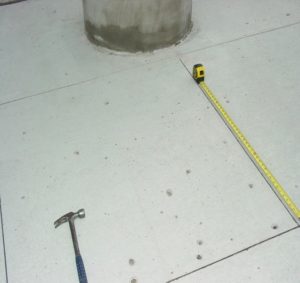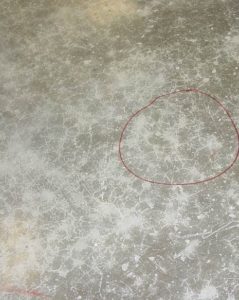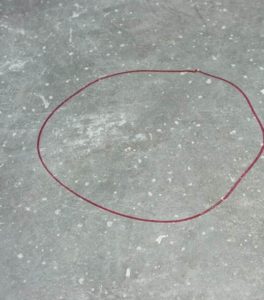
In Minnesota, Iowa, and South Dakota, we sometimes see aggregate popouts, particularly in concrete flatwork. Popouts are unsightly surface defects that may appear a few hours to a few weeks after placement. Both fine- and coarse aggregates can cause popouts. In a sidewalk or highway pavement you may be willing to accept some popouts. However, if you’re placing a large slab for an industrial floor or a big box store, you won’t want it to look like that. And if you’re building an airfield pavement, debris from popouts would be a hazard to aircraft.
Once the popout appears, the damage is done and you really can’t fix it. Any patching will be as conspicuous as the popout itself. So your only hope is to prevent it.
What causes aggregate popouts?
Petrographic examination of popouts in the laboratory showed that they result from alkali-silica reaction. In this case the reactive aggregates are shale particles. They occur in both fine- and coarse aggregate.
It would appear … that the popouts are the result of alkali-silica reactivity involving the opaline microfossils in the shale particles.—Landgren and Hadley
However, the timing of the reaction is very different from “classic” alkali-silica reaction, which doesn’t manifest itself until years after concrete placement. In evaluating aggregates for their tendency to cause deleterious expansions, we use aggressive methods to accelerate the reactions. For example, in ASTM C1260 we crush coarse aggregates to sand size, increase the alkali content of the mortar bars, and raise the temperature to well above normal laboratory temperatures. That gives us a result in 14 days. By contrast, fine-aggregate popouts occur within a few hours of placement at ambient temperatures and without additional alkalis.
Even with low-alkali cement, popouts can still occur. That’s because the alkali concentration isn’t the same everywhere in concrete. The worst-case scenario occurs on hot, dry, windy days—in other words, conditions that promote drying. All concrete bleeds to some extent. That is, the relatively dense cement and aggregate particles settle, leaving the water near the surface. Because alkalis are so readily soluble, they remain in the water. When the surface dries, the alkalis concentrate near the concrete surface, ready to react with the shale.
Unfortunately, what we do to mitigate “classic” alkali-silica reaction—using fly ash, slag cement, or silica fume—doesn’t help prevent popouts. That’s because of the timing. The pozzolanic reaction between calcium hydroxide from cement hydration and the reactive silica in supplementary cementitious materials takes weeks—long after the popouts have occurred.
Choosing the right aggregate
There are two approaches to limiting aggregate popouts. You can specify the right aggregates for your application. The Minnesota Department of Transportation (MnDOT) does this, specifying stricter limits than ASTM C33 on problematic materials. MnDOT 3137 specifies coarse aggregates for general use, bridge superstructures, and concrete pavements. Each has different limits on undesirable constituents. Table 3137-1, Coarse Aggregate for General Use, limits shale, iron oxide particles, spall materials, soft particles, and clay, as well as the total of all of these constituents. The corresponding limits for aggregates for bridge superstructures are even more stringent. On the other hand, aggregates for concrete pavements do not have comparable limits. Ontario’s Ministry of Transportation uses a similar approach.
Some pits in the eastern part of the Twin Cities have shale-free aggregates. Alternatively, you could mix natural fine aggregate with manufactured (crushed) sand to dilute the shale. This practice will increase the water demand, so you’ll need more water reducers in the concrete.
Concrete floors for big box stores are often specified at corporate headquarters by engineers who may not be familiar with local aggregates. “Classic” alkali-silica reaction is fairly common throughout the country, so they’ll normally make provision for evaluating the aggregate and mitigating expansions. However, aggregate popouts are a local phenomenon, and the normal tests don’t identify them.
Some generic specifications include provisions for using the relevant state DOT aggregate specification if it’s more stringent than ASTM C33. This is wise, but it may not suffice for all applications. An acceptable number of popouts for a highway pavement or a bridge superstructure, which most of us see only while traveling at speed, will not be acceptable on an industrial floor or in a retail space. If you want anything close to zero popouts, you need to take a different approach.
Curing is the best prevention


Unless you can obtain pure crushed igneous aggregate at an acceptable cost, you need to make sure the alkalis don’t concentrate at the concrete surface. That is, you need to limit drying. Keep the concrete covered between operations, and apply wet curing immediately after troweling. An abundance of water is key, whether that’s by ponding or wet burlap. Ideally, you’ll pond the surface and then drain off the excess water, taking the alkalis with it.
It is extremely important that these wet curing procedures be initiated soon after troweling. If such procedures are delayed too long, they are no longer effective in preventing popouts.—Landgren and Hadley
Curing methods such as sealers, membranes, or polyethylene sheeting, all of which prevent drying without adding water, are worse than useless. They provide enough moisture to promote alkali-silica reaction without diluting the alkali concentration. In the photographs above, one coat of sealer retained enough moisture to promote popouts. Two coats retained enough moisture for the alkali-silica gel to accumulate and imbibe some water, making for an even more unsightly appearance.
Because curing is essential to preventing aggregate popouts, it’s a good idea to make it a separate pay item. That calls the contractor’s attention to it and ensures there’s money in the contract to make sure it gets done properly.
